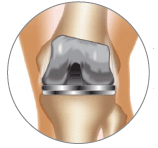By Nancy Simpkins
 When arthritis in the knee causes severe pain or disability that is not improved by conservative treatments, your doctor may recommend surgery to replace the joint. In total knee replacement surgery, damaged cartilage is removed, and a metal or plastic joint is attached to the femur (thigh bone), tibia (shin) and patella (knee cap).
When arthritis in the knee causes severe pain or disability that is not improved by conservative treatments, your doctor may recommend surgery to replace the joint. In total knee replacement surgery, damaged cartilage is removed, and a metal or plastic joint is attached to the femur (thigh bone), tibia (shin) and patella (knee cap).
Minimally invasive total knee replacement
Some orthopedic surgeons do quadriceps-sparing minimally invasive total knee replacement, which requires a smaller incision than in traditional surgery, and eliminates the need to cut the quadriceps tendon and muscles, and to dislocate the kneecap. Patients benefit from a shorter hospital stay, shorter recovery time and a smaller scar.
Physical therapy after knee replacement surgery
After knee replacement surgery, your physical therapist can teach you exercises that strengthen the muscles in the knee and increase the range of motion in the joint. Physical therapy can also help reduce pain and swelling. Some patients may need to relearn good standing and walking techniques. Many patients with knee pain develop a habit of using the hips to stand up from a chair, which increases the risk of falling and could lead to future knee osteoarthritis. After knee replacement surgery eliminates the pain, a physical therapist can train these patients to use their quadriceps muscles instead.
How long does a total knee replacement last?
In addition to improving function in the knee, exercise can help control weight, which is important since excess weight can reduce the life of the new joint. When knee replacement began in the 1970’s, the life of the replacement joint was estimated at 10 years. Current replacement joints are expected to last closer to 20 years.